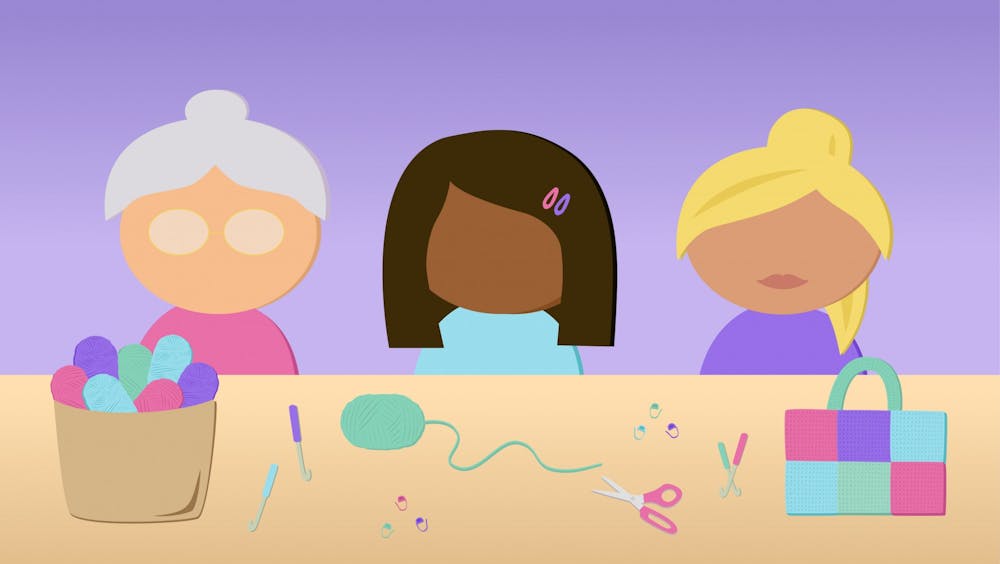You may have dissed crocheting in the past because it was your grandma’s favorite pastime hobby (maybe her only hobby), but don’t make that same mistake twice.
With influencers like Emma Chamberlain and Olivia Rodrigo posting their crocheted fits, more of Gen-Z have hit up their local craft stores and hopped on the yarn band wagon.
Crocheted tops, pants and sweaters are back and better than ever. And the best part? Like its first iteration, there's no wrong way to wear the yarn.
Crocheted garments are receiving their well deserved time in the spotlight on social media platforms like YouTube and TikTok. Video content creators have uploaded tutorials replicating influencers such as Emma Chamberlain's color-blocking vest.
Everyone from freshmen to seniors on UofSC's campus are transforming the retro trend into something that fits their aesthetic.
The final verdict: It’s no longer a grandma's craft.
Though grandmas will always be the OG crocheters, UofSC crocheters are close competitors.
Junior Taylor Simons learned to crochet at 10 years old from her grandmother.
“She made afghans for the whole family and we would sit and crochet together for hours,” Simons says. “I have made a bag for my water bottle, a bralette top and I am in the process of making an afghan for my grandmother for Christmas.”
Similarly, sophomore Calista Pushman learned to crochet from her great-grandmother.
“My great-grandma always crocheted and knitted the most beautiful blankets and I remember always wanting to be able to carry on what she was able to create,” Pushman, a crocheter of five years, says. “My sophomore year of high school, my step-grandma visited and ended up teaching me and I’ve just never stopped. It was the best gift I could’ve been given.”
But not all UofSC crocheters started eons ago.
Sophomore Beth Bryerton started crocheting in 2020 right before the pandemic started.
“I’ve made a couple of sweaters, a really big rainbow cardigan that's really fun and a lot of different tank tops that I played around with my my own patterns and making different fruit themed ones,” Bryerton says.
"I started crocheting to try something new and different,” sophomore Shelby Leiss says.
“I’m not a very creative person so it’s kind of outside of my comfort zone, but it’s been fun trying to learn new stitches and get better at being more consistent. Right now, I'm working on making a Lemon Meringue costume for Halloween!"
ENVIRONMENTAL IMPACTS:
Crocheting takes one step to individuality and one giant leap towards reducing fast fashion.
To rebut the fast-paced changing trends, "slow fashion" as defined by Good On You is “an awareness and approach to fashion, which considers the processes and resources required to make clothing, particularly focusing on sustainability.” These clothes aim to be ethical, eco-friendly and lasting.
“I think crocheting reduces fast fashion because people will go to small businesses or shop handmade since the products are so unique,” Simons says. “It’s also a great way to fill up your own closet with new pieces if you can’t or don’t want to spend a lot of money.”
Sustainable living website, Woolly Green, writes “because people are buying more new clothes, they are using them less: the average piece of clothing is worn 36% fewer times now than it was 15 years ago.”
Fast fashion, which has been popularized by TikTok, has increased the amount of textiles created and simultaneously sent to landfills in the last year.
According to Woolly Green, “on average, Americans throw away 81 pounds of textiles each year. This amounts to 26 billion pounds of textile waste in the United States alone.”
As TikTok Gen-Z fashion environmentalists encourage teens to break up with fast fashion culprits like Shein and Romwe, smaller businesses are finding ways to mix creative freedom, artistic expression and environmental awareness.
Crocheting one’s clothes or buying from UofSC crocheters satisfies a desire to be environmentally friendly.
“While it’s definitely easier to just buy things like clothes and stuffed animals and bags, it’s great to be able to provide these things by hand,” Pushman said. “It makes me feel like I’m making my own small difference in living a more sustainable lifestyle.”
Handmade garments and accessories are an amazing way to become part of the slow fashion movement.
HEALTH IMPACTS:
“For me crocheting is very calming,” Pushman said. “Sometimes it’s just nice to sit, Zen-out and do a very repetitive activity.”
70% of people involved in the survey led by Pippa Burns and Rosemary Van Der Meer for the University of Wollongong Australia said that crocheting improved their memory and concentration.
“Crocheting is a great stress reliever for me, especially on projects with a lot of repetition because it becomes muscle memory and can be almost meditative,” Simons said.
The Craft Yarn Council reports that in a research survey of 3,100, subjects found stress reduction in 85% and mood improvement in 68% of the group. 93% of knitters and crocheters reported the crafts gave them a feeling of accomplishment, 56% a sense of confidence, 43% better concentration, 27% better problem solving and 23% increased memory.
“It is a healthy outlet to relieve stress after a long day,” Junior Sarah Kincaid says.
British Olympian Tom Daley pre-gamed his Olympic races with crocheting and knitting sessions.
“One thing that has kept me sane throughout this whole process is my love for knitting and crochet and all things stitching,” Daley said.
SO, WHAT’S IN IT FOR YOU?
Crocheting is one way for people to see your personality with just one item.
“The best part is there’s always a reward at the end,” Pushman said. "Most of the time I make stuffed animals and give them as gifts to family and friends. From start to finish, it’s just the best hobby to have.”
“I think crocheting is a great opportunity for creative expression, as there are so many different types of projects: fashion, comfort, décor,” Simons says. “There’s that feeling of pride when you complete a project and get to actually put it to use. Having people ask where you got your top and seeing how shocked they are when you say 'oh, I made it' is such a cool feeling.”
“I don’t plan on dropping this amazing hobby in the future,” Pushman says.
So maybe you don’t have any yarn or know what a crochet hook looks like, but with a drive to your local craft store, a lot of patience and the help of YouTube strangers guiding you through, the possibilities are endless.
Next time someone asks “You crochet?” you can respond with “Yes!”
MATERIALS NEEDED:
-TWO DIFFERENT COLOR YARNS
-NEEDLE THAT MATCHES THE SIZE OF THE YARN
-PATIENCE FRIEND… PATIENCE
GINGHAM TOTE BAG TUTORIAL:
8 by 10 in
- SLIP STITCH + CHAIN 50 WITH YOUR LIGHTER COLOR
- SINGLE CROCHET IN THE FIRST THREE STITCHES
- CHANGE COLORS BY CONTINUING THE FOURTH STITCH, BUT BEFORE YOU YARN OVER THE LAST TIME… STOP AND DROP THE COLOR YOU WERE USING AND REPLACE IT WITH THE OTHER COLOR
- REPEAT STEPS 2-3 UNTIL YOU HAVE DONE A SINGLE CROCHET IN EACH CHAIN. REMEMBER TO ALTERNATE COLORS EVERY FOUR STITCHES
- WHEN YOU GET TO THE END OF THE ROW, MAKE SURE TO CHAIN ONE WITH THE COLOR YOU WANT YOUR NEXT ROW TO BE AND FLIP YOUR WORK
- KEEP REPEATING STEPS 2 AND 5 TILL YOU HAVE THE DESIRED AMOUNT OF ROWS.
- ROUGHLY 9 ROWS = 8 INCHES
TO MAKE THE HANDLE:
- SLIP STITCH + CHAIN 70 WITH YOUR LIGHTER COLOR
- SINGLE CROCHET IN THE FIRST THREE STITCHES
- CHANGE COLORS BY CONTINUING THE FOURTH STITCH, BUT BEFORE YOU YARN OVER THE LAST TIME… STOP AND DROP THE COLOR YOU WERE USING AND REPLACE IT WITH THE OTHER COLOR
- REPEAT STEPS 2-3 UNTIL YOU HAVE DONE A SINGLE CROCHET IN EACH CHAIN. REMEMBER TO ALTERNATE COLORS EVERY FOUR STITCHES
- WHEN YOU GET TO THE END OF THE ROW:,MAKE SURE TO CHAIN ONE WITH THE COLOR YOU WANT YOUR NEXT ROW (BECAUSE YOU WILL ONLY HAVE ONE ROW OF COLOR, YOUR CHAIN AT THE END OF THE ROW SHOULD STAY THE SAME COLOR) TO BE AND FLIP YOUR WORK
- KEEP REPEATING STEPS 2-5 UNTIL YOU HAVE CROCHETED FOUR ROWS OF 70 SINGLE CROCHETS IN EACH ROW
ONCE YOU HAVE CROCHETED THE BODY AND HANDLE:
- FOLD THE BAG IN HALF, THERE SHOULD BE 25 SINGLE CROCHETS ON EACH SIDE OF THE BAG
- TO ASSEMBLE TO HANDLE TO THE BAG: AS STATED BY E.CLAIRE MAKERY
- THREAD THE NEEDLE AND TURN CROCHET PIECES WRONG SIDE UP. INSERT THE NEEDLE THROUGH THE CORNER ON THE RIGHT SIDE, AND PULL THE THREAD THROUGH.
- INSERT THE NEEDLE THROUGH THE BOTTOM CORNER ON THE LEFT SIDE, AND PULL THROUGH.
- MOVE THE NEEDLE BACK TO THE RIGHT SIDE AND INSERT IT HORIZONTALLY THROUGH A STITCH ON THE RIGHT SIDE THROUGH TO ONE ON THE LEFT.
- KEEP DOING STEP THREE ALL THE WAY UP THE REST OF THE EDGES TO CREATE STITCH BARS THAT GO FROM ONE SIDE TO THE OTHER.
- AS YOU GO, YOU CAN PULL THE BAG TIGHT EVERY 5 OR SO STITCHES TO TIGHTEN UP THE SEAM AND SECURE THE TWO PIECES TOGETHER. THEN FASTEN OFF AMD WEAVE IN THE ENDS.



